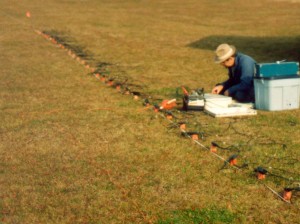Seismic Rental Equipment
Seismic Rental discusses equipment and methods for conducting seismic refraction, reflection, shear wave, and multichannel analysis of surface waves MASW surveys. Seismographs, geophones, cables, and sources come in many different configurations. This is one reason people rent seismic equipment. Cables come in different lengths with different types of connectors. Geophones are designed to respond to a specific range of frequencies. Seismographs are commonly designed with 24 channels or 48 channels. If you are looking for seismic rental equipment such as cables, geophones, and seismographs (e.g., a Geode system by Geometrics) try Geophysical Equipment Rental. They also have variety of equipment for engineering geophysics or near surface geophysical surveys.
Engineering geophysical methods generally utilize higher resolution instruments when compared to oil, gas, and deep exploration surveys. Higher resolution geophysical equipment that is used during a shallow engineering geophysical survey may not respond well to the seismic energy produced for greater depths of penetration. Some examples are provided below.
Geophones
While 10 Hz or 25 Hz geophones are rented for seismic refraction and shear-wave surveys, 40 Hz geophones may yield more detail for a shallow seismic reflection survey. MASW and shear-wave surveys are often conducted with 4.5 or 10 Hz geophones. Downhole shear-wave surveys commonly use triaxial geophones mounted in a borehole tool (e.g. Geostuff Wall-Lock Borehole Geophones). Borehole geophysical surveys require special equipment for clamping the geophone to the borehole.
Seismic cables
Seismic cables come in different lengths and types of connectors. You need to match the cable connector to the seismograph or roll box. Depending on the type of seismograph used, a roll box may be needed to select a group of geophones along the geophone array. Geophones have different types of connectors or plugs. Two common types of plugs are Kooter and Mueller clips. Seismic cables come with these two types of geophone takeouts and are equally spaced. The distance between takeout depends on the type of geophysical seismic survey that is being conducted. Some seismic cables come with 12 geophone connections per cable and some come with 24 geophone connections per cable. Cables with more than 24 geophone takeouts often become too heavy and difficult to handle.
Seismic sources
Seismic sources for engineering geophysics range from a hammer, weight drop, explosion (shot gun), or variable frequency vibration unit. A sledge hammer often works well for shallow engineering geophysics. A sledge hammer and strike plate may provide enough energy for a shallow reflection survey to reach 100s of feet of penetration or enough energy for a seismic refraction survey to reach 100 feet deep. Greater depths of investigation can require larger energy sources such as a weight drop. The depth of penetration with a specific source is usually site specific. Contact Seismic Rental.com for someone to assist with determining what seismic rental equipment you may be for your geophysical survey or follow this link to find out more about engineering geophysics.
For help today, fill out SeismicRental.Com’s form:
